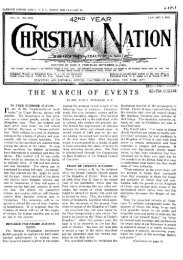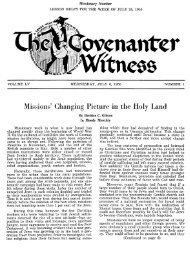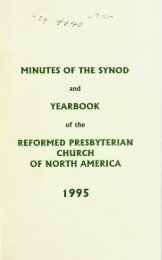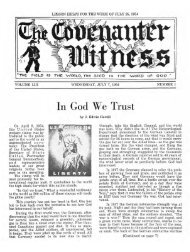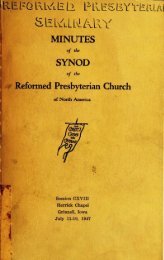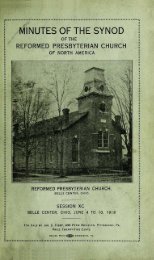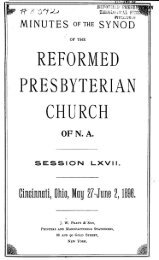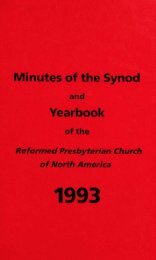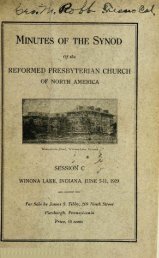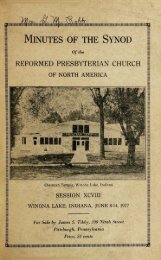Covenanter Witness Vol. 86 - Rparchives.org
Covenanter Witness Vol. 86 - Rparchives.org
Covenanter Witness Vol. 86 - Rparchives.org
Create successful ePaper yourself
Turn your PDF publications into a flip-book with our unique Google optimized e-Paper software.
The Origin and Principlesof the Reformed Presbyterian Church"In no other country in the world was the Reformationso complete or so thorough as in Scotland."With these words Dr. Renwick summarizes for usthat whole movement which had its beginnings evenbefore the Reformation in Europe, and became nationallyeffective during the periods known in Scottish history asthe First and Second Reformation (1528(60)—1567;1637—1651).For us who cherish the history of this period, it issufficient merely to recall the names of those who werethe founding fathers of the faith in those epoch-makingdays: Patrick Hamilton, Ge<strong>org</strong>e Wishart, John Knox,Andrew Melville, John Forbes, John Welsh, among othersin Scotland; and the names of Cunningham, Blair,Hamilton, Dunbar, Livingstone, in Northern Ireland.Though we mention names, it must be rememberedthat the Scottish Reformation was not merely a reformationby individuals. Individuals and great leaders therewere, but their teaching and principles were accepted bythe masses and leavened the whole of society. And thisgives the Scottish Reformation quite a different character,from that of England, e.g., where the Reformed religionwas imposed upon the people by the civil rulers withoutreally moving the people as a whole. In Scotland thecommon people accepted Reformation truths gladly forthemselves, and thus Renwick can describe the Reformationthere as "complete and thorough."Seen from this point of view, then, it is understandablethat the Scottish Reformation should be a"Covenanted" Reformation. This means that the people,not only as a church but also as a nation, with Israel fortheir example, entered into solemn covenant with God,faithfully to observe all that His Word required of them asa Christian nation as well as Church.The first noteworthy covenant was the drawing up ofthe National Covenant of Scotland in 1581, which wassworn and subscribed by the King and his household, andlater by people of all ranks throughout the landSolemn though his oath was, the King sho-tlv afterrepudiated the Covenant, and by word and deed tookactive steps to make Scotland a nation of covenantbreakers,and thus return the whole nation back to thespiritual darkness from which they had so recently beendelivered.No better was the policy pursued by Charles I.The measures taken to enforce that King's wishesended in popular revolt, and the National Covenant wasagain taken up, added to, and sworn and subscribed by noless than 60,000 people, on February 28, 1638, inGreyfriar's Churchyard. This was the inauguration of theSecond Reformation.Another memorable Covenant document subscribedby Rev. Arnold Palmerto, not only by Scotland, but by England and Ireland also,was the Solemn League and Covenant of 1643.This document was approved by the populace as awhole; a fact made plain by the opening words. "WeNoblemen, Barons, Knights, Gentlemen, Citizens,Burgesses, Ministers of the Gospel, and Commons of allsorts ... all subscribe, and each one of us for himself, withour hands lifted up to the most high God, do swear. . ."and then follow the solemn God-honoring obligationsunder which the people placed themselves, with the desirethat the Divine Response would be, that "the Lord maydelight to dwell in the midst of us."The Solemn League and Covenant was again swornby all Scotland in 1648, by Parliament in 1649, and twicesubscribed to by Charles II in hypocritical fashion, in 1650and 1651.From this it is plain why stress has been laid uponthe fact that the Scottish Reformation was a "Covenanted"Reformation, with the nation as a whole entering intosolemn covenant with God, binding itself to regard thisCovenant as a perpetual obligation. Consequently thisperiod of enthusiasm and first love for the Lord has beenrecognized as the period of the Scottish Church's greatestpurity.You notice then, that we make a distinction betweenthe era of the First and Second Reformation and theperiod that follows; for in the former we have to do with aCovenanted Nation and Church, but in the days thatfollow there is a National Church that grows progressivelyunfaithful to its solemn Covenants, and concurrent withthis the emergence of a faithful remnant.The defection was consequent upon the accession ofCharles II. For that King, had taken solemn oath tosupport and defend the Presbyterian Church of Scotland,and upon the National Covenant and the Solemn Leagueand Covenant being produced and read, the Kingsolemnly swore to them. But no sooner was the thronesecure than he determined to overthrow and undo thewhole work of Reformation in State and Church that hehad so solemnly sworn to support.The first step taken to realize his aim was the passingof the Act of Supremacy; by this the King was constitutedas supreme judge in all matters civil and ecclesiastical.Next he added the Oath of Allegiance, which declaredthat it was an act of treason to deny the King's supremacyin Church and State. Charles crowning act of treacherywas the passing of the Act Recissory, which condemned asrebellion and treason all the steps taken from 1638 to 1650for the reformation of religion, and the National Covenantand the Solemn League and Covenant were condemned asunlawful oaths.see page 5JUNE 9, 1971 3



